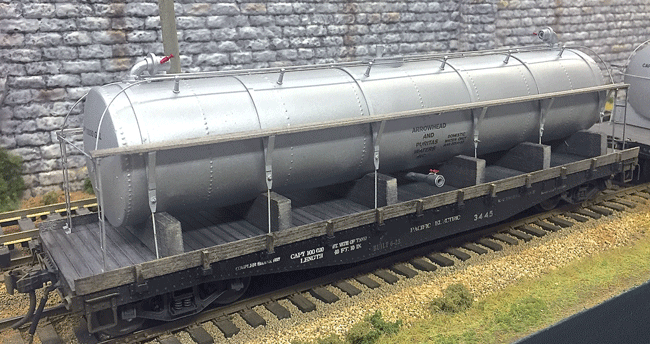Well, my plans for world domination have been on hold awhile, but now with a nice kick in the pants opportunity to design new "Freemo" modules for our HO club, I think I can start moving forward. Currently the club has the older two rail lumber rich modules most are familiar with. Most of the modular systems were designed to have two or three rails at the front side of the module with a huge blank space in the rear for what ever you could cram in there. I never liked the concept and until Freemo became standardized hadn't considered doing much more than my own system that could fold into a home layout sometime in the future. Basically, Freemo has a single rail that starts and ends at the center of the ends of the module. Generally 24" wide they can be any length given the returns are reverse loops. These are designed to both run and operate like a real railroad having engines running in both directions. Check it out on line, plenty of info there.
Free-mo site
More to the mission at hand, I am building three modules for the upcoming show. Our internal standard will be 18' wide with adapter sections 24" for working with other clubs. The one I plan on keeping will be a simple straight section with a road crossing that will be modeled after the location of a PE Relay station. This is a picture of a part of the Eastern Section of PE on the way up to the Arrowhead Water facility.
Not the most lush of locations, but with the crossing and the power poles and other details, will make an interesting module to photograph on.
Here is a shot of the structure in the distance.
Arrowhead Water operations could be a whole other very interesting PE operations layout point to point.
History The terminus was a deep canyon to the north of LA where the natural springs were located. The mountain side had a huge Arrowhead rock shape on it's flank which was the origin of the springs name. The area had a loading spur, a few structures and beyond it a resort that would be too far away to model. The track wound down to the city were the actual bottling plant was located. Here are a few illustrations of what it looked like in the 20's, what I think is a worthy modeling project.
This is from the track side, glass lined tanks on flats were shoved into the end spur and off loaded. For those fortunate enough to have one of the Metro Models three flask Flat Cars, this would be a nice companion for it. So far any searches for photo's of the model have come up empty. Later they went to the more standardized ACF style tanks, none that I can find labeled Arrowhead specifically.
Above are some shots I found on line of a brass model which will really help when I get around to scratch building them for my layout.
Decal at one time produced by Custom Traxx Decals...still available but in short supply. I think I will grab a few of these for my library and also to apply to an ACF 8,000 Gal tank car model as a fudge given the glass flats are too old for my modeling era.
Here is an old postcard I found on line showing the other side of the plant. Possibly just the loading side could be modeled with the sign to represent the building.
Back up in the hills, you can see a PE 44 Tonner holding a tank car being filled behind it. I'm currently looking for more information on the site, but it looks to be a pretty simple transfer location.
Here is a sample model built for a lecture about making the Arrowhead Tank Car Model. This makes things a lot clearer...which I could attend the class.
Big time score during my hunt for allusive Arrowhead Tank cars. Still researching the scheme but WOW
A nice home built version, looking like a straight forward kit bash...need to look more at this one.
Here's a model I found on line. Length of the tank is off, but nice to see something.
As for delivery, it depends on your era, but here is a cool shot of a 40's vintage truck you could build using a cab and chassis from a Mini Metal Works truck.
How about a series of road signs?
These lattice work billboards scream period..
Some images from the 100th anniversary of Arrowhead
At some point I'll get this part of the blog set up as a more cohesive post. I reached out to the Pacific Electric Facebook page and these images appeared. My modeling White Whale finally arrived! Very excited about getting this kind of information that will allow me to finally model the scene.
the holy grail of Arrowhead water loading. LOL Given the information I was able to do a quick model of the water pipe in preperation for a full blown 3D model I will print. The site had two tracks, one for loading and the other for staging I suppose and had three stations. Combined with some overhead shots I have a basic idea of what the area was like and how to model it.
The stand was turned out of steel rod stock with brass and styrene. Funny how such a small detail can become such a big deal.

































































